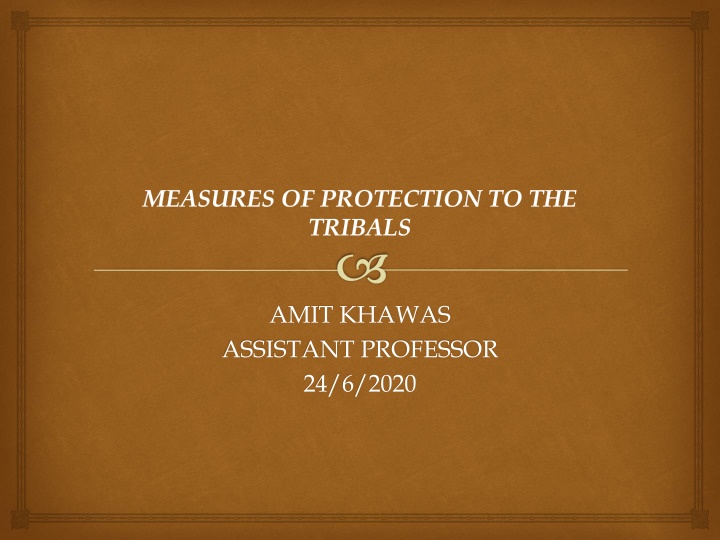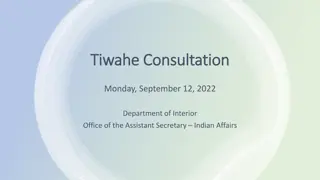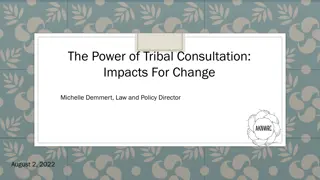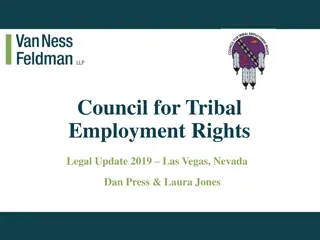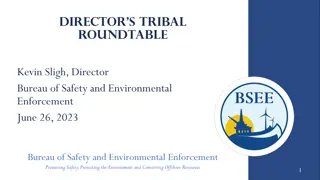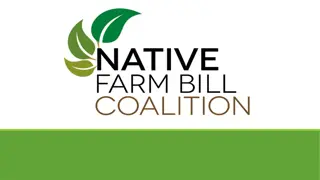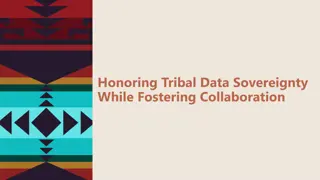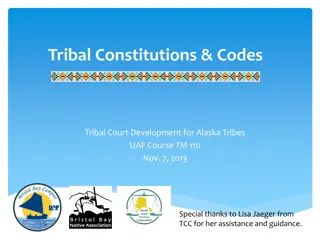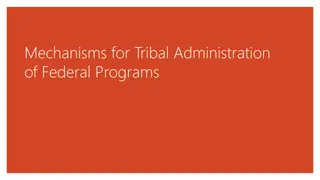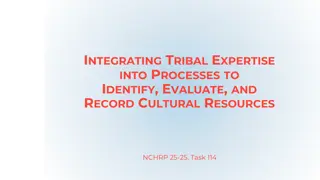Measures of Protection for Tribal Development in India
The post-independence era in India saw significant efforts towards tribal development, emphasizing principles like respecting tribal rights, preserving culture, and avoiding imposition. Various viewpoints were presented, including policies of isolation, assimilation, and integration. These approaches aimed to address tribal issues effectively and ensure their well-being within the larger society.
Download Presentation

Please find below an Image/Link to download the presentation.
The content on the website is provided AS IS for your information and personal use only. It may not be sold, licensed, or shared on other websites without obtaining consent from the author.If you encounter any issues during the download, it is possible that the publisher has removed the file from their server.
You are allowed to download the files provided on this website for personal or commercial use, subject to the condition that they are used lawfully. All files are the property of their respective owners.
The content on the website is provided AS IS for your information and personal use only. It may not be sold, licensed, or shared on other websites without obtaining consent from the author.
E N D
Presentation Transcript
MEASURES OF PROTECTION TO THE TRIBALS AMIT KHAWAS ASSISTANT PROFESSOR 24/6/2020
MEASURES OF PROTECTION TO THE TRIBALS After independence, the Constituent Assembly appointed sub- committee under the chairmanship of A.V. Thakkar, after whose recommendation the development of tribal areas become an integral part of development of the Indian people as a whole.
The goals of tribal development should be follow the five fundamental principles. Tribal people should be developed along the lives of their own wishes and imposition of anything on them should be avoided. Their traditional arts and culture should be encouraged in every way. Tribal rights in land and forests should be respected A team of their own people should be trained to do the work of administration and development The Tribals areas should not be over administered or they will be confused with the multiple schemes. The results of these programmes should be judged not by statistics or the amount of money spent but by the quality of human character that is evolved.
Various solutions have been presented for effectively dealing with the Tribal problems which have been approached from three viewpoints as follows: 1. POLICY OF ISOLATION: The policy was given by Hutton and V. Elwin, who suggested that the tribals must be kept at a distance from the rest of the society and allow the tribal people to live their own life with happiness and freedom. They proposed a scheme of national park for the tribal. The tribals would be in a position to maintain their independent identity They would be free from the exploitation of outsiders. Those who support this approach say that sufficient time must be given to the tribals to assimilate themselves with the rest of the community. Rajaji National Park Photo: A tribal Village near to the National Park
POLICY OF ASSIMILATION Assimilation is a process of adopting the ways of another culture and fully becoming a part of a different society. Those who adopted this policy wanted the assimilation of tribals into the main stream national life. According to this approach we cannot deal with tribal problems only on the basis of tribal culture and life but by changing them into a new community with the rest of the people in India The limitation of this approach is that complete assimilation is a difficult task because the tribals are not prepared to give up their traditional beliefs, practices and ideas. Picture shows the assimilation of two cultures (force assimilation)
POLICY OF INTEGRATION: Integration means joining another society or becoming a part of different groups without giving up their own ways. Integration is based on equality where either the cultures or groups are influencing each other. Thus integration is a two way process. . This policy of integration was supported by the thinkers like Jawaharlal Nehru.
WELFARE PROGRAMMES FOR SCHEDULE TRIBES: The tribals are also the important citizens of India and hence promotion of their welfare is of equal importance. The central and the state-government and various voluntary organisations have undertaken various steps in this regard. Some of the tribal welfare measures are: Constitutional safeguards: various provisions to safeguard the interest of the tribals have been made such as; 1.Giving equal rights and opportunities to all citizens of India including the tribal without any discrimination. Article 14 says that state shall not deny to any person equality before the law or the equal protection of the laws within the territory of India. Article 15 of the constitution states that no citizen of India shall be discriminated on the basis of religion, race, caste, sex or place of birth.
2. Giving reservation in employment and in the legislature for the tribals Article 335 Claims of Scheduled Castes and Scheduled Tribes to services and posts. Article 330 Reservation of seats for Scheduled Castes and Scheduled Tribes in the House of the People. Article 332, Reservation of seats for Scheduled Castes and Scheduled Tribes in the Legislative Assemblies of the States.
3. Giving tribal right to own property in any part of the country. 4. Protecting the economic and educational interests of the tribals Article 46, Promotion of Educational and Economic interests of Scheduled Castes, Scheduled Tribes and other weaker sections. Special Central Assistance: The Tribal sub-plans (TSP) evolved for the tribal development projects during the fifth five year plan (1974-79) and today cover 22 states and two union territories and about 38 million tribal populations. The specific objectives set forth under the tribal sub- plan strategy were: Raising production in the field of agriculture, small industries, horticulture, and animal husbandry Elimination of exploitation of tribals in money lending, bondage, use of forests, liquor vending etc. Development of education and training programmes Development of tribal areas upgrading of environment of tribal areas
Economic programmes and facilities: Various projects have been undertaken to improve their economic positions such as a) Development through Five Year Plan b) To loosen the grip of the moneylenders and the mahajans on the tribals, the government organized Large Multi-Purpose Societies (LAMPS) in tribal areas for giving loans to purchase the necessities of life. These societies supplied the tribals with improved seeds, fertilizers, pesticides, etc. by giving relief to the tribals from exploitation of middle-men, contractors, and money lenders. c) The 20 point programme, too, focused attention on the development of schedule tribes, including assisting the tribal families economically to enable them to cross the poverty line. d) Vocational training in tribal areas which aims at developing skills of tribal youth in order to gain employment or self employment. e) Giving encouragement to crafts and home industries. f) Making agriculture stable by persuading the tribals to give up shifting cultivation and to settle permanently in a place by making agriculture their occupation.
Educational facilities: The importance of education as an agency of modernization as well as a source of employment has long been realised in our national plans for tribal welfare. A greater proportion of the grant both from state and central sectors have been invested in imparting education at primary, pre-matric, and post-matric levels. However, the wastage and drop-outs in tribal education have been equally stupendous. Schools are established in tribal areas where education up to 10th standards has been made completely free for them. There are Ashrama schools for providing basic education and vocational training for ST. 20% of the seat are reserved in education and relaxation is made for them in respect of age-limit and qualifying marks.
MEDICAL FACILITIES: Running of Health Care Institutions: The Scheduled Tribes Development Department is running Allopathic outpatient clinics in the remote scheduled tribe areas. Ambulance services and medical camps are also being conducted through these Out Patient Clinics. Medical Assistance through Hospitals: The, intention of the scheme is to provide medical care to Scheduled Tribes people through selected hospital in the state. Under the scheme treatment assistance is provided to tribal people affected by various diseases through approved hospitals in the state. The allotted amount is used for providing/ purchase of medicines. Tribal Relief Fund: The scheme is intended to provide financial assistance to the ST population affected by various diseases and natural calamity. Financial assistance is given to the Scheduled Tribes who are below poverty line and who suffer from various diseases including major diseases like cancer, heart/kidney/brain ailments etc. Janani-JanmaRaksha: The nutritional issues of mother and child due to inadequate pre and post maternal care. The scheme is envisaged for extending timely assistance 1000 per month for 18 months beginning from third month of the pregnancy to the month in which the child attains one year. Payment is made through bank account. Mobile medical unit and primary health care centres are established all over the tribal areas with well medical facilities and medical professionals.
Role of voluntary organisation: Tribal welfare is not the only concern of government alone. Private organisation and individuals interested in the tasks of tribal upliftment must also be given encouragement in this regard. Tribals and the Forest: Regulation of 1952, allows the local tribes certain concessions to use the forest. These concessions are: 1. Right to take water for agricultural purposes. 2. Digging of wells or canals for agricultural purposes. 3. Free grazing in open forests (under passes). 4. Removal of stones and earth for domestic or agricultural use. 5. Removal of timbers/bamboos/reeds/canes, etc., for construction and repairs of houses and for agricultural implements. 6. Collection and removal of head load of dead wood for domestic use. 7. Fishing and hunting excluding the protected fauna. 8. Shifting cultivation. 9. Collection of minor forest produces for domestic consumption and for sale
